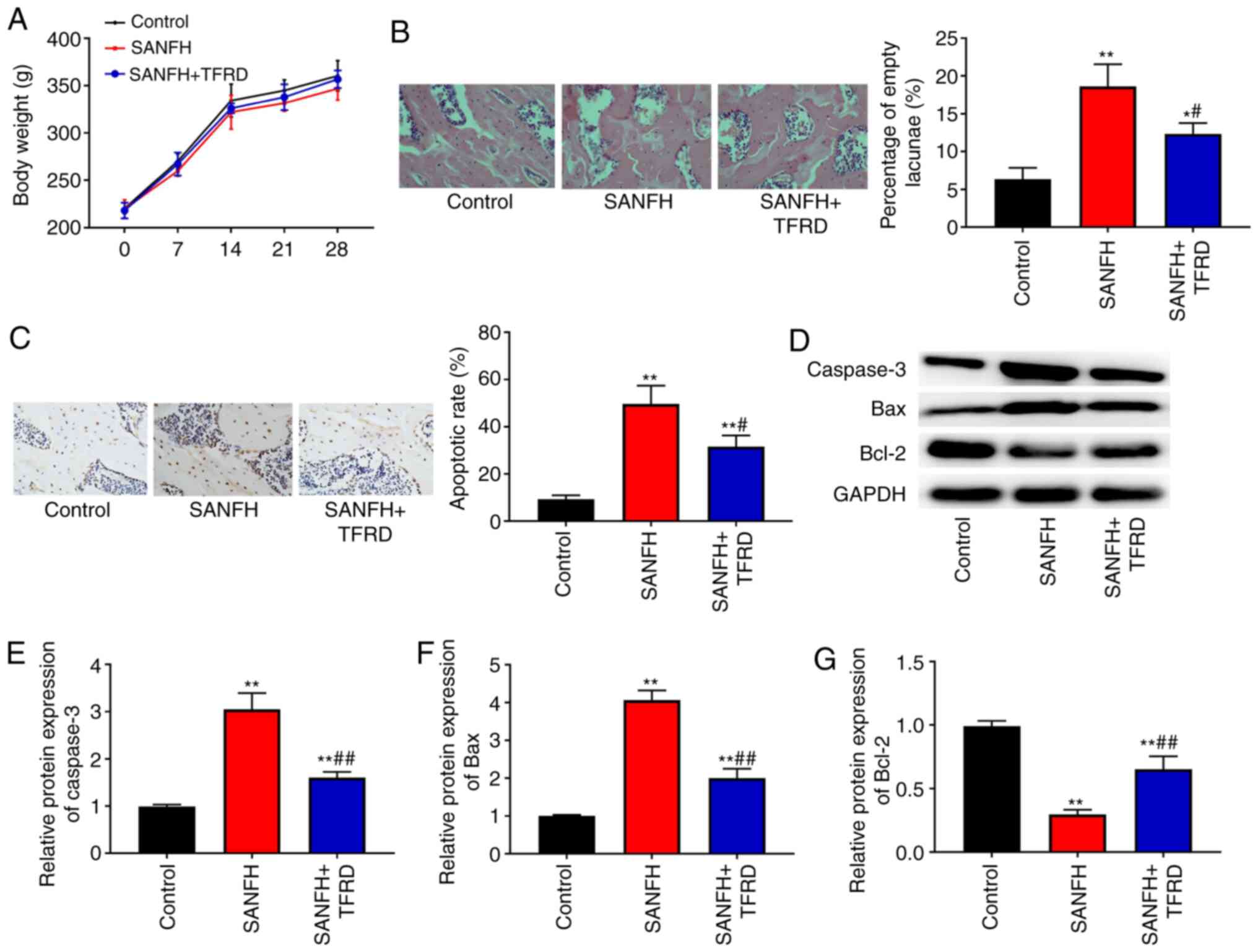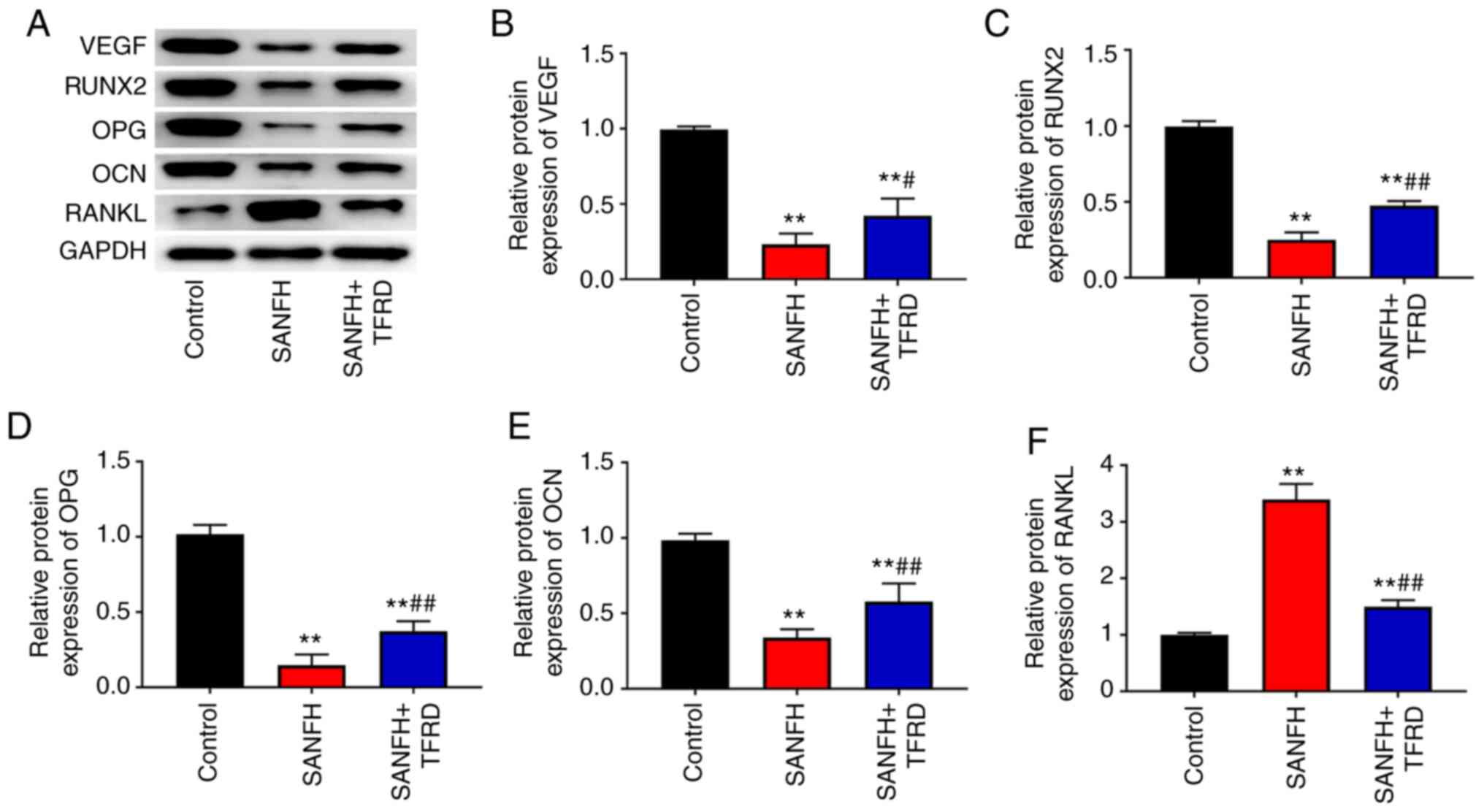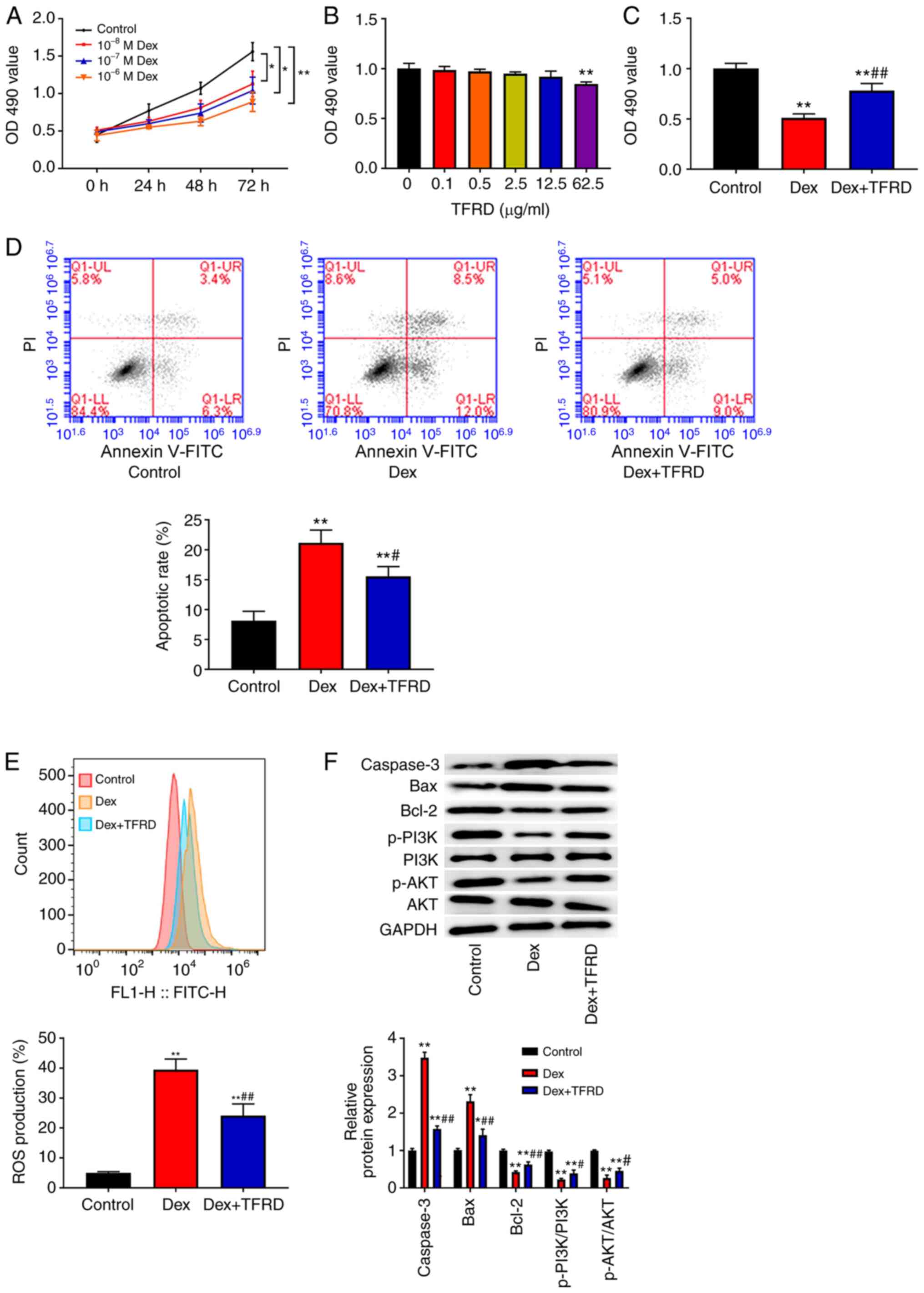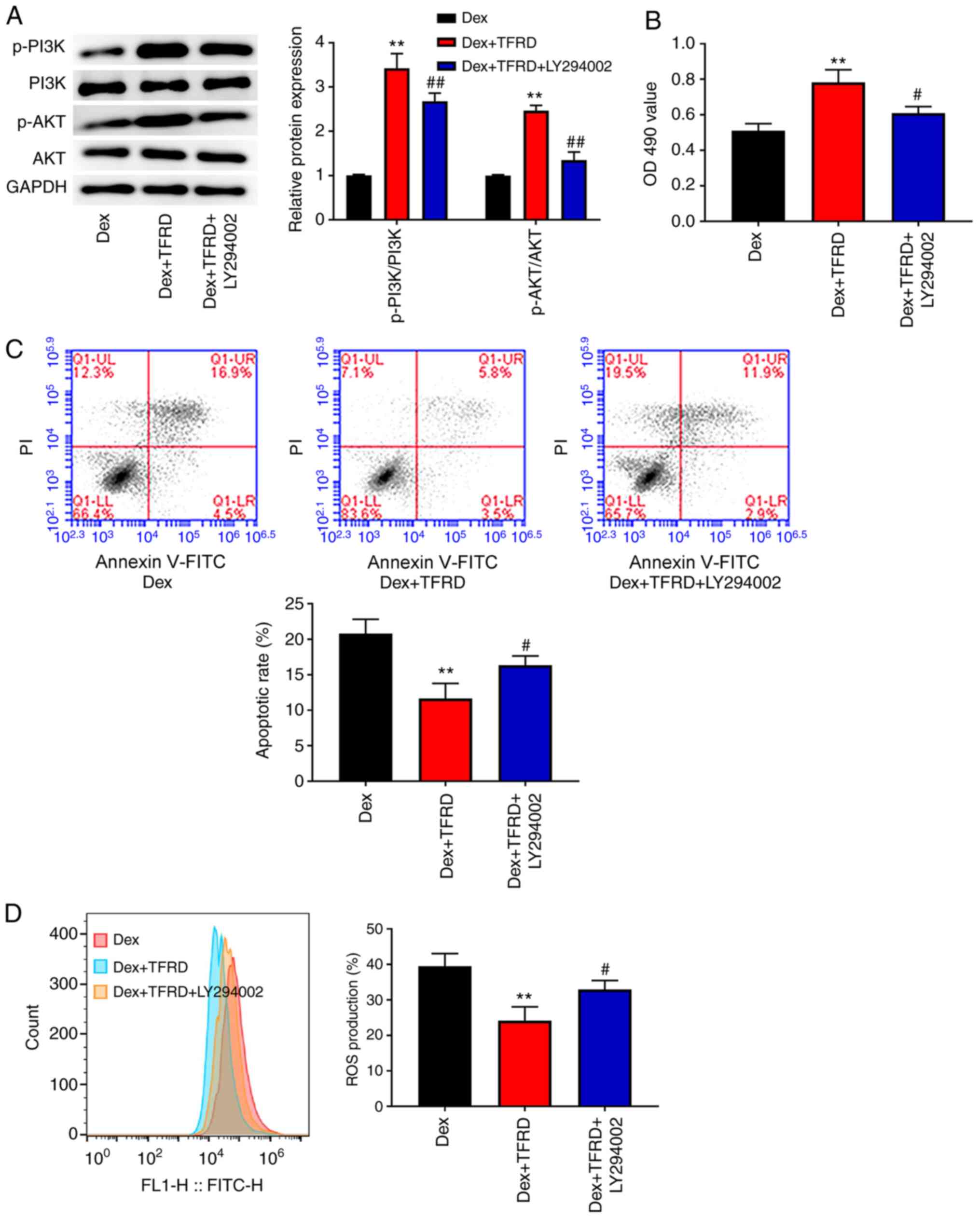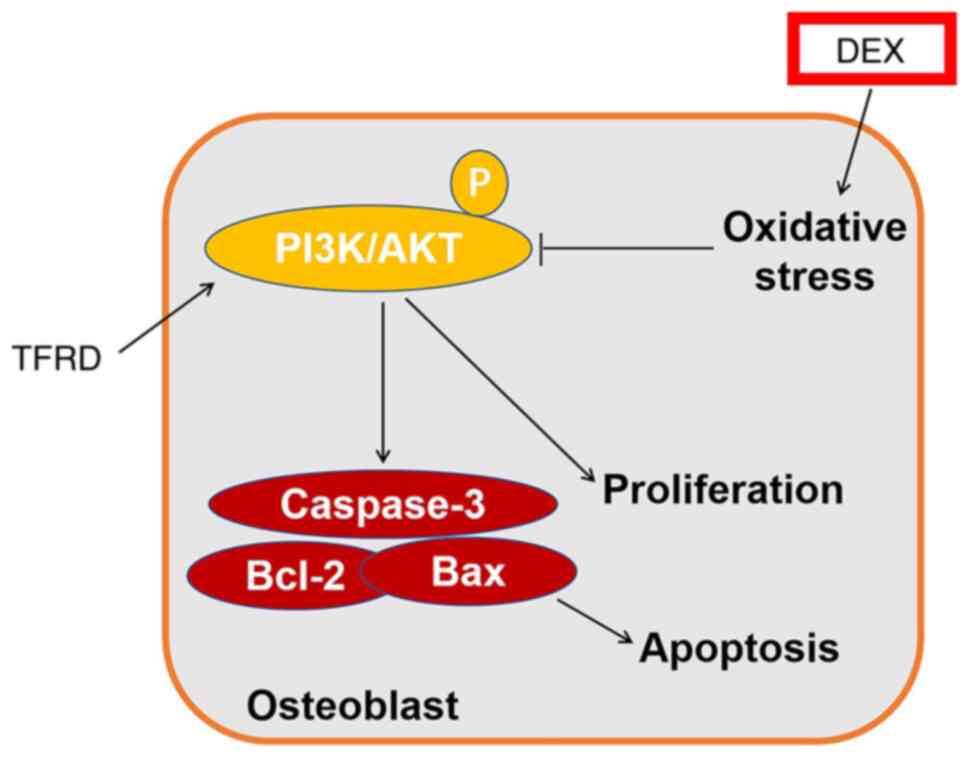|
1
|
Xiang S, Li Z and Weng X: The role of
lncRNA RP11-154D6 in steroid-induced osteonecrosis of the femoral
head through BMSC regulation. J Cell Biochem. 120:18435–18445.
2019. View Article : Google Scholar : PubMed/NCBI
|
|
2
|
Yan YQ, Pang QJ and Xu RJ: Effects of
erythropoietin for precaution of steroid-induced femoral head
necrosis in rats. BMC Musculoskelet Disord. 19:2822018. View Article : Google Scholar : PubMed/NCBI
|
|
3
|
Xue XH, Feng ZH, Li ZX and Pan XY:
Salidroside inhibits steroid-induced avascular necrosis of the
femoral head via the PI3K/Akt signaling pathway: In vitro and in
vivo studies. Mol Med Rep. 17:3751–3757. 2018.PubMed/NCBI
|
|
4
|
Ren X, Fan W, Shao Z, Chen K, Yu X and
Liang Q: A metabolomic study on early detection of steroid-induced
avascular necrosis of the femoral head. Oncotarget. 9:7984–7995.
2018. View Article : Google Scholar : PubMed/NCBI
|
|
5
|
Wong GKC, Poon WS and Chiu KH:
Steroid-induced avascular necrosis of the hip in neurosurgical
patients: Epidemiological study. ANZ J Surg. 75:409–410. 2015.
View Article : Google Scholar
|
|
6
|
Bae WY, Kim HY, Choi KS, Chang KH, Hong
YH, Eun J, Lee NK and Paik HD: Investigation of Brassica juncea,
Forsythia suspensa, and Inula britannica: Phytochemical properties,
antiviral effects, and safety. BMC Complement Altern Med.
19:2532019. View Article : Google Scholar : PubMed/NCBI
|
|
7
|
Li L, Hou X, Xu R, Liu C and Tu M:
Research review on the pharmacological effects of astragaloside IV.
Fundam Clin Pharmacol. 31:17–36. 2017. View Article : Google Scholar : PubMed/NCBI
|
|
8
|
Zhang Y, Jiang J, Shen H, Chai Y, Wei X
and Xie Y: Total flavonoids from Rhizoma Drynariae (Gusuibu) for
treating osteoporotic fractures: Implication in clinical practice.
Drug Des Devel Ther. 11:1881–1890. 2017. View Article : Google Scholar : PubMed/NCBI
|
|
9
|
Lin FX, Du SX, Liu DZ, Hu QX, Yu GY, Wu
CC, Zheng GZ, Xie D, Li XD and Chang B: Naringin promotes
osteogenic differentiation of bone marrow stromal cells by
up-regulating Foxc2 expression via the IHH signaling pathway. Am J
Transl Res. 8:5098–5107. 2016.PubMed/NCBI
|
|
10
|
Wong RW, Rabie B, Bendeus M and Hägg U:
The effects of rhizoma curculiginis and rhizoma drynariae extracts
on bones. Chin Med. 2:132007. View Article : Google Scholar : PubMed/NCBI
|
|
11
|
Kuang MJ, Zhang WH, He WW, Sun L, Ma JX,
Wang D and Ma XL: Naringin regulates bone metabolism in
glucocorticoid-induced osteonecrosis of the femoral head via the
Akt/Bad signal cascades. Chem Biol Interact. 304:97–105. 2019.
View Article : Google Scholar : PubMed/NCBI
|
|
12
|
Guntur AR and Rosen CJ: The skeleton: A
multi-functional complex organ. New insights into osteoblasts and
their role in bone formation: The central role of PI3Kinase. J
Endocrinol. 211:123–130. 2011. View Article : Google Scholar : PubMed/NCBI
|
|
13
|
Gu Y, Du J, Si M, Mo J, Qiao S and Lai H:
The roles of PI3K/Akt signaling pathway in regulating MC3T3-E1
preosteoblast proliferation and differentiation on SLA and SLActive
titanium surfaces. J Biomed Mater Res A. 101:748–754. 2013.
View Article : Google Scholar : PubMed/NCBI
|
|
14
|
Ma J, Sawai H, Ochi N, Matsuo Y, Xu D,
Yasuda A, Takahashi H, Wakasugi T and Takeyama H: PTEN regulates
angiogenesis through PI3K/Akt/VEGF signaling pathway in human
pancreatic cancer cells. Mol Cell Biochem. 331:161–171. 2009.
View Article : Google Scholar : PubMed/NCBI
|
|
15
|
Zhang J, Liu X, Li H, Chen C, Hu B, Niu X,
Li Q, Zhao B, Xie Z and Wang Y: Exosomes/tricalcium phosphate
combination scaffolds can enhance bone regeneration by activating
the PI3K/Akt signaling pathway. Stem Cell Res Ther. 7:1362016.
View Article : Google Scholar : PubMed/NCBI
|
|
16
|
Hu J, Gu Y and Fan W: Rg1 protects rat
bone marrow stem cells against hydrogen peroxide-induced cell
apoptosis through the PI3K/Akt pathway. Mol Med Rep. 14:406–412.
2016. View Article : Google Scholar : PubMed/NCBI
|
|
17
|
National Research Council: Guide for the
Care and Use of Laboratory Animals: Eighth edition. The National
Academies Press; Washington, DC: 2011
|
|
18
|
Spiers DE and Candas V: Relationship of
skin surface area to body mass in the immature rat: A
reexamination. J Appl Physiol Respir Environ Exerc Physiol.
56:240–243. 1984.PubMed/NCBI
|
|
19
|
Lu X, Xiong Z, Li J, Zheng S, Huo T and Li
F: Metabonomic study on ‘Kidney-Yang Deficiency syndrome’ and
intervention effects of Rhizoma Drynariae extracts in rats using
ultra performance liquid chromatography coupled with mass
spectrometry. Talanta. 83:700–708. 2011. View Article : Google Scholar : PubMed/NCBI
|
|
20
|
Feng Z, Zheng W, Tang Q, Cheng L, Li H, Ni
W and Pan X: Fludarabine inhibits STAT1-mediated up-regulation of
caspase-3 expression in dexamethasone-induced osteoblasts apoptosis
and slows the progression of steroid-induced avascular necrosis of
the femoral head in rats. Apoptosis. 22:1001–1012. 2017. View Article : Google Scholar : PubMed/NCBI
|
|
21
|
Wang A, Ren M and Wang J: The pathogenesis
of steroid-induced osteonecrosis of the femoral head: A systematic
review of the literature. Gene. 671:103–109. 2018. View Article : Google Scholar : PubMed/NCBI
|
|
22
|
Song HM, Wei YC, Li N, Wu B, Xie N, Zhang
KM, Wang SZ and Wang HM: Effects of Wenyangbushen formula on the
expression of VEGF, OPG, RANK and RANKL in rabbits with
steroid-induced femoral head avascular necrosis. Mol Med Rep.
12:8155–8161. 2015. View Article : Google Scholar : PubMed/NCBI
|
|
23
|
Xu L, Huang G, Guo X, Zhou Q and He S:
Total flavonoids, extracted from Polygonum knotweed L, exert
beneficial hepatoprotection against liver injury. J Cell Biochem.
120:12677–12683. 2019. View Article : Google Scholar : PubMed/NCBI
|
|
24
|
Cheng Y, Yang Z, Shi J, Yang J, Zhao J, He
Y and Qi M: Total flavonoids of Epimedium ameliorates testicular
damage in streptozotocin-induced diabetic rats by suppressing
inflammation and oxidative stress. Environ Toxicol. 35:268–276.
2020. View Article : Google Scholar : PubMed/NCBI
|
|
25
|
Guo Y, Xing L, Chen N, Gao C, Ding Z and
Jin B: Total flavonoids from the Carya cathayensis Sarg. leaves
inhibit HUVEC senescence through the miR-34a/SIRT1 pathway. J Cell
Biochem. 120:17240–17249. 2019. View Article : Google Scholar : PubMed/NCBI
|
|
26
|
Kang SN, Lee JS, Park JH, Cho JH, Park JH,
Cho KK, Lee OH and Kim IS: In vitro anti-osteoporosis properties of
diverse Korean Drynariae rhizoma phenolic extracts. Nutrients.
6:1737–1751. 2014. View Article : Google Scholar : PubMed/NCBI
|
|
27
|
Weinstein RS: Glucocorticoid-induced
osteonecrosis. Endocrine. 41:183–190. 2012. View Article : Google Scholar : PubMed/NCBI
|
|
28
|
Assouline-Dayan Y, Chang C, Greenspan A,
Shoenfeld Y and Gershwin ME: Pathogenesis and natural history of
osteonecrosis. Semin Arthritis Rheum. 32:94–124. 2002. View Article : Google Scholar : PubMed/NCBI
|
|
29
|
Inoue A and Ono K: A histological study of
idiopathic avascular necrosis of the head of the femur. J Bone
Joint Surg Br. 61-B:138–143. 1979. View Article : Google Scholar : PubMed/NCBI
|
|
30
|
Ichiseki T, Ueda S, Ueda Y, Tuchiya M,
Kaneuji A and Kawahara N: Involvement of necroptosis, a newly
recognized cell death type, in steroid-induced osteonecrosis in a
rabbit model. Int J Med Sci. 14:110–114. 2017. View Article : Google Scholar : PubMed/NCBI
|
|
31
|
Varoga D, Drescher W, Pufe M, Groth G and
Pufe T: Differential expression of vascular endothelial growth
factor in glucocorticoid-related osteonecrosis of the femoral head.
Clin Orthop Relat Res. 467:3273–3282. 2009. View Article : Google Scholar : PubMed/NCBI
|
|
32
|
Carlevaro MF, Cermelli S, Cancedda R and
Cancedda FD: Vascular endothelial growth factor (VEGF) in cartilage
neovascularization and chondrocyte differentiation: Auto-paracrine
role during endochondral bone formation. J Cell Sci. 113:59–69.
2000.PubMed/NCBI
|
|
33
|
Carmeliet P, Ferreira V, Breier G,
Pollefeyt S, Kieckens L, Gertsenstein M, Fahrig M, Vandenhoeck A,
Harpal K, Eberhardt C, et al: Abnormal blood vessel development and
lethality in embryos lacking a single VEGF allele. Nature.
380:435–439. 1996. View Article : Google Scholar : PubMed/NCBI
|
|
34
|
Zheng LZ, Cao HJ, Chen SH, Tang T, Fu WM,
Huang L, Chow DHK, Wang YX, Griffith JF, He W, et al: Blockage of
src by specific siRNA as a novel therapeutic strategy to prevent
destructive repair in steroid-associated osteonecrosis in rabbits.
J Bone Miner Res. 30:2044–2057. 2015. View Article : Google Scholar : PubMed/NCBI
|
|
35
|
Piuzzi NS, Anis HK and Muschler GF:
Osteonecrosis of the femoral head with subchondral collapse. Cleve
Clin J Med. 86:511–512. 2019. View Article : Google Scholar : PubMed/NCBI
|
|
36
|
Zhu C, Lv Y, Qian C, Qian H, Jiao T, Wang
L and Zhang F: Proliferation and osteogenic differentiation of rat
BMSCs on a novel Ti/SiC metal matrix nanocomposite modified by
friction stir processing. Sci Rep. 6:388752016. View Article : Google Scholar : PubMed/NCBI
|
|
37
|
Qian C, Zhu C, Yu W, Jiang X and Zhang F:
High-fat diet/low-dose streptozotocin-induced type 2 diabetes in
rats impacts osteogenesis and wnt signaling in bone marrow stromal
cells. PLoS One. 10:e01363902015. View Article : Google Scholar : PubMed/NCBI
|
|
38
|
Croucher PI, Mcdonald MM and Martin TJ:
Bone metastasis: The importance of the neighbourhood. Nat Rev
Cancer. 16:373–386. 2016. View Article : Google Scholar : PubMed/NCBI
|
|
39
|
Peng WX, Ye C, Dong WT, Yang LL, Wang CQ,
Wei ZA, Wu JH, Li Q, Deng J and Zhang J: MicroRNA-34a alleviates
steroid-induced avascular necrosis of femoral head by targeting
Tgif2 through OPG/RANK/RANKL signaling pathway. Exp Biol Med
(Maywood). 242:1234–1243. 2017. View Article : Google Scholar : PubMed/NCBI
|
|
40
|
Zhang H, Zhou F, Pan Z, Bu X, Wang Y and
Chen F: 11β-hydroxysteroid dehydrogenases-2 decreases the apoptosis
of MC3T3/MLO-Y4 cells induced by glucocorticoids. Biochem Biophys
Res Commun. 490:1399–1406. 2017. View Article : Google Scholar : PubMed/NCBI
|
|
41
|
Xu X, Wen H, Hu Y, Yu H, Zhang Y, Chen C
and Pan X: STAT1-caspase 3 pathway in the apoptotic process
associated with steroid-induced necrosis of the femoral head. J Mol
Histol. 45:473–485. 2014. View Article : Google Scholar : PubMed/NCBI
|
|
42
|
Li DW, Liu ZQ, Chen W, Yao M and Li GR:
Association of glycogen synthase kinase-3β with Parkinson's disease
(Review). Mol Med Rep. 9:2043–2050. 2014. View Article : Google Scholar : PubMed/NCBI
|
|
43
|
Chao DT and Korsmeyer SJ: BCL-2 family:
Regulators of cell death. Annu Rev Immunol. 16:395–419. 1998.
View Article : Google Scholar : PubMed/NCBI
|
|
44
|
Ravindran J, Gupta N, Agrawal M, Asb B and
Rao PVL: Modulation of ROS/MAPK signaling pathways by okadaic acid
leads to cell death via, mitochondrial mediated caspase-dependent
mechanism. Apoptosis. 16:145–161. 2011. View Article : Google Scholar : PubMed/NCBI
|
|
45
|
Deng S, Zhou JL, Fang HS, Nie ZG, Chen S
and Peng H: Sesamin protects the femoral head from osteonecrosis by
inhibiting ROS-induced osteoblast apoptosis in rat model. Front
Physiol. 9:17872018. View Article : Google Scholar : PubMed/NCBI
|
|
46
|
Sato A, Tu X, McAndrews K, Plotkin L and
Bellido T: Prevention of glucocorticoid induced-apoptosis of
osteoblasts and osteocytes by protecting against endoplasmic
reticulum (ER) stress in vitro and in vivo in female mice. Bone.
73:60–68. 2015. View Article : Google Scholar : PubMed/NCBI
|
|
47
|
Li J, He C, Tong W, Zou Y, Li D, Zhang C
and Xu W: Tanshinone IIA blocks dexamethasone-induced apoptosis in
osteoblasts through inhibiting Nox4-derived ROS production. Int J
Clin Exp Pathol. 8:13695–13706. 2015.PubMed/NCBI
|
|
48
|
Cakir E, Yilmaz A, Demirag F, Oguztuzun S,
Sahin S, Yazici UE and Aydin M: Prognostic significance of
micropapillary pattern in lung adenocarcinoma and expression of
apoptosis-related markers: Caspase-3, bcl-2, and p53. APMIS.
119:574–580. 2011. View Article : Google Scholar : PubMed/NCBI
|















